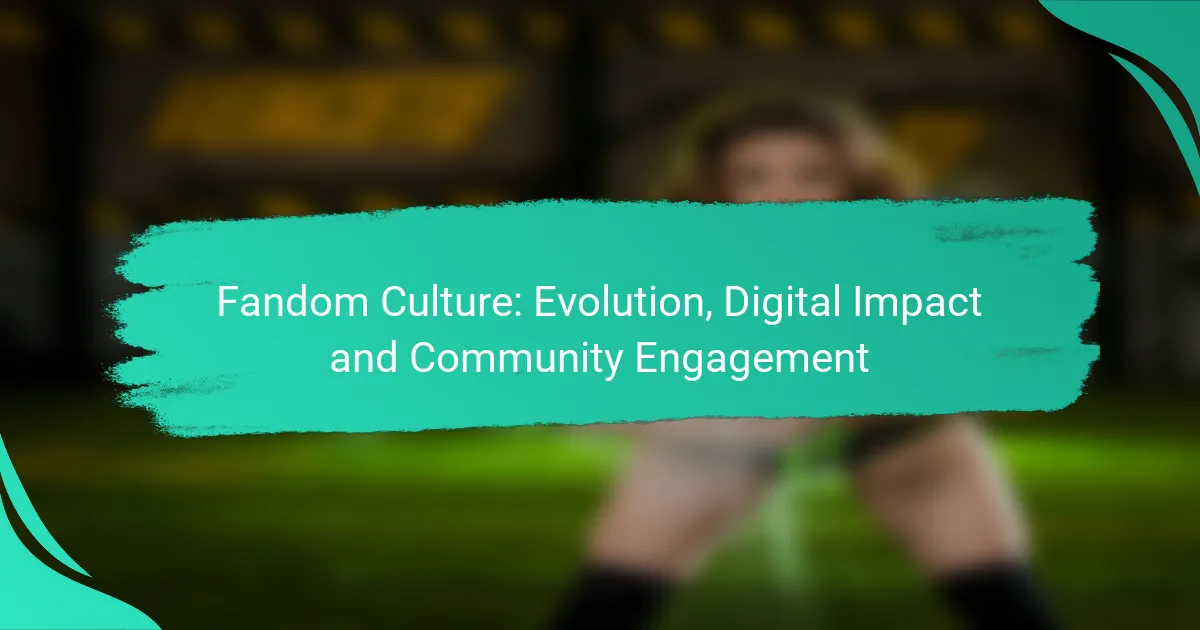Fandom culture has undergone a remarkable transformation, driven by technological advancements and evolving media consumption habits. The rise of digital platforms has not only enhanced connectivity among fans but also fostered a more interactive and participatory environment, allowing for deeper engagement with content and each other.
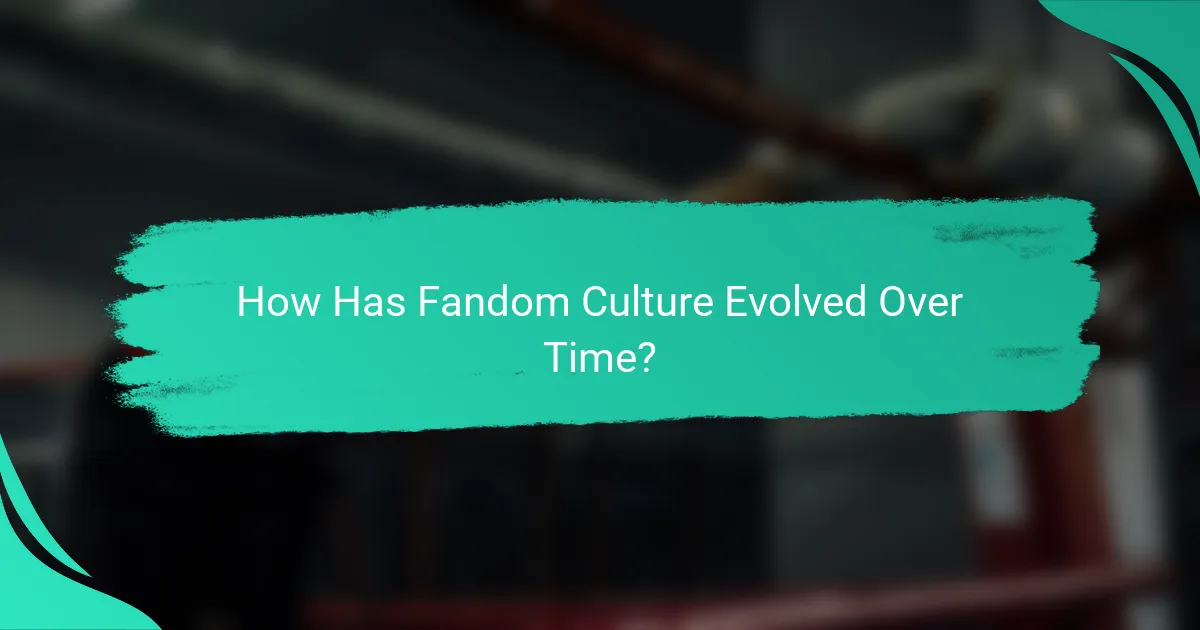
How Has Fandom Culture Evolved Over Time?
Fandom culture has transformed significantly, influenced by technological advancements and changes in media consumption. From grassroots communities to global networks, the evolution reflects shifts in how fans interact and engage with their interests.
Historical milestones in fandom
Fandom culture has roots in the early 20th century, with the rise of fan clubs and conventions for literature and film. The 1960s saw the emergence of organized fandoms, particularly around science fiction, leading to the first conventions like Worldcon.
In the 1980s and 1990s, the advent of the internet revolutionized fandom, allowing fans to connect globally through forums and mailing lists. This period marked the beginning of online fan communities, expanding the reach and influence of fandom.
Influence of media on fandom evolution
Media has played a crucial role in shaping fandom culture, with franchises like Star Wars and Harry Potter creating dedicated followings. The rise of streaming services has further transformed fandom by providing instant access to content, fostering real-time discussions and engagement.
Social media platforms have become vital for fandom expression, enabling fans to share content, create fan art, and participate in discussions. This shift has made fandom more accessible, allowing diverse voices to contribute to the culture.
Shifts in community engagement
Community engagement in fandom has evolved from in-person gatherings to online interactions. Fans now participate in virtual events, live streams, and online conventions, which have become increasingly popular, especially during global events like the COVID-19 pandemic.
Additionally, fan-driven initiatives, such as crowdfunding for projects or charity events, highlight the proactive role of communities. Fans are not just consumers but active participants, shaping the direction of their favorite franchises and supporting causes they care about.
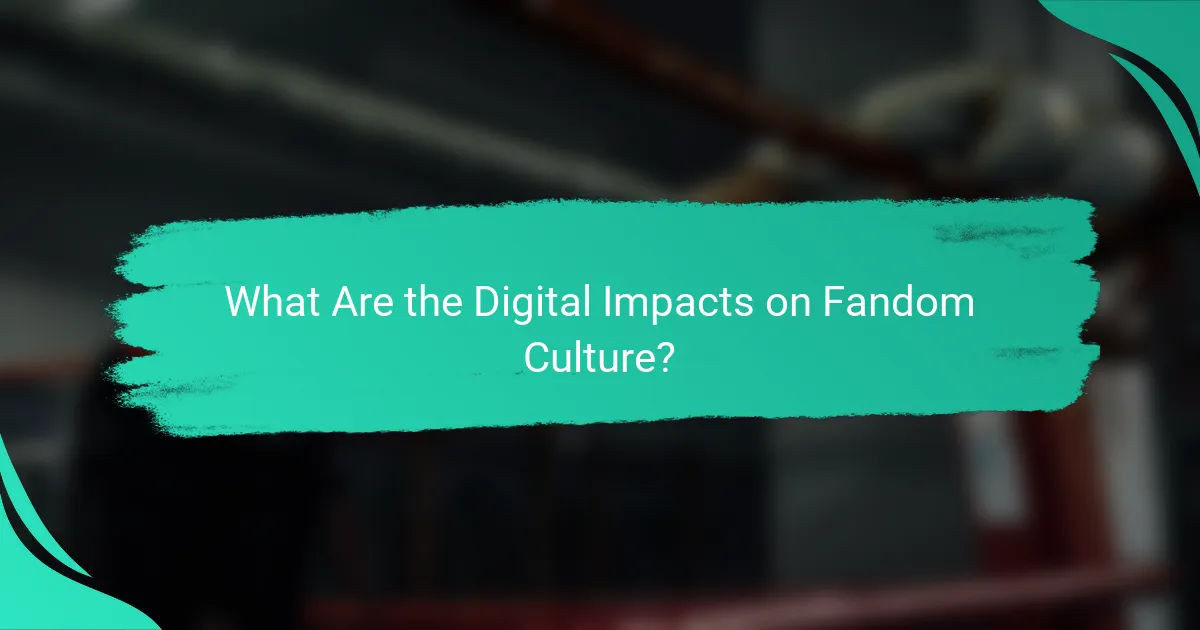
What Are the Digital Impacts on Fandom Culture?
The digital landscape has significantly transformed fandom culture by enhancing connectivity, accessibility, and engagement among fans. Social media, streaming services, and online communities have reshaped how fans interact with content and each other, creating a more dynamic and participatory environment.
Role of social media platforms
Social media platforms like Twitter, Instagram, and TikTok play a crucial role in fandom culture by facilitating real-time discussions and sharing of fan-created content. Fans can easily connect with others who share their interests, leading to the rapid spread of memes, fan art, and theories.
These platforms also allow creators and celebrities to engage directly with their fanbase, fostering a sense of community and loyalty. However, the fast-paced nature of social media can sometimes lead to misinformation or heated debates, which fans should navigate carefully.
Impact of streaming services
Streaming services such as Netflix, Disney+, and Hulu have revolutionized how fans consume media, providing instant access to a vast library of content. This accessibility encourages binge-watching and deeper engagement with series and films, often leading to the formation of dedicated fan groups.
Moreover, these platforms frequently release exclusive content and behind-the-scenes features, enhancing the fan experience. However, the competition among streaming services can fragment fandoms, as fans may need multiple subscriptions to access all their favorite shows.
Influence of online fan communities
Online fan communities, such as forums, subreddits, and Discord servers, serve as vital hubs for discussion and collaboration among fans. These spaces allow fans to share insights, create fan fiction, and organize events, enriching the overall fandom experience.
Participation in these communities can lead to lasting friendships and collaborations, but it’s essential for fans to be mindful of community guidelines and respect differing opinions. Engaging positively can enhance the sense of belonging and support within the fandom.

How Do Digital Products Enhance Fandom Engagement?
Digital products significantly enhance fandom engagement by providing fans with interactive and immersive experiences that deepen their connection to their favorite franchises. These products, ranging from merchandise to online events, leverage technology to create community and participation among fans.
Fan merchandise and collectibles
Digital fan merchandise and collectibles include virtual items, NFTs, and exclusive online products that fans can purchase or trade. These items often feature unique designs or limited editions tied to specific events, enhancing their value and appeal. For example, a popular video game may release digital skins or in-game items that fans can buy, fostering a sense of ownership and pride.
When considering fan merchandise, it’s essential to evaluate authenticity and value. Look for official releases from trusted sources to avoid counterfeit items. Engaging with fan communities can also provide insights into the most sought-after collectibles.
Online events and conventions
Online events and conventions have become a staple for fandoms, allowing fans to participate in discussions, panels, and meet-and-greets from anywhere in the world. These virtual gatherings often feature live streams with creators, exclusive content reveals, and interactive Q&A sessions, making them accessible to a broader audience.
To maximize enjoyment, fans should plan ahead by checking schedules and registering early for popular events. Participating in chat rooms or forums during these events can enhance the experience through real-time interaction with other fans.
Interactive fan experiences
Interactive fan experiences include online games, virtual reality environments, and social media challenges that engage fans in unique ways. These experiences often allow fans to immerse themselves in the storylines and worlds they love, creating a more profound connection to the content.
When engaging with interactive experiences, consider exploring platforms that offer community features, such as forums or leaderboards. This not only enhances personal enjoyment but also fosters connections with other fans who share similar interests.
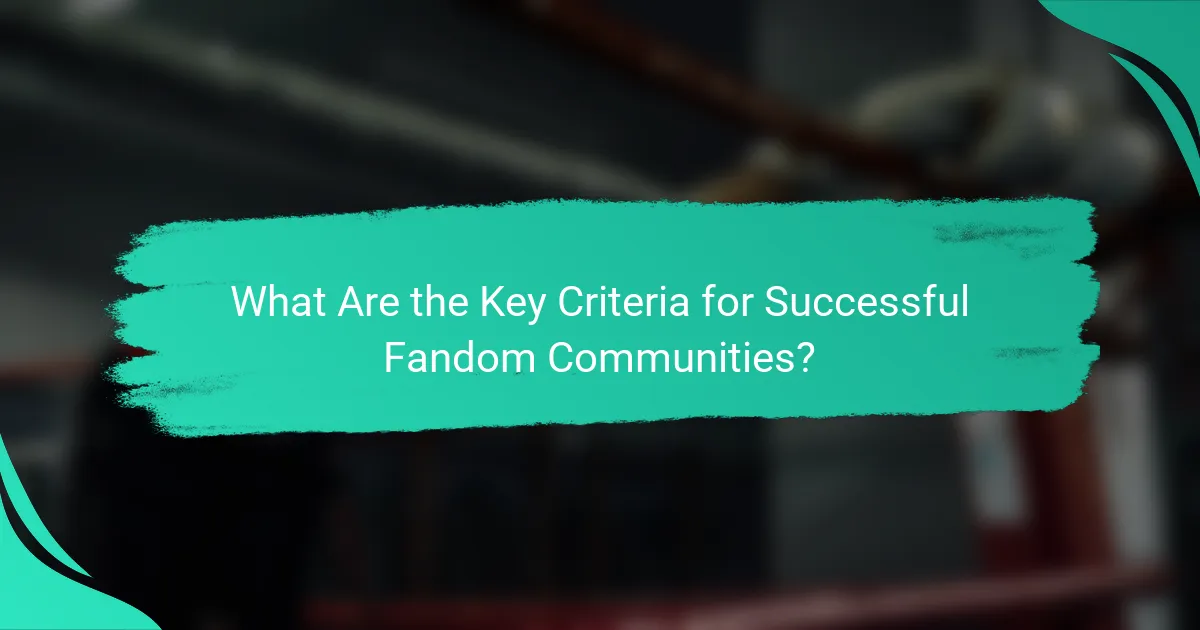
What Are the Key Criteria for Successful Fandom Communities?
Successful fandom communities thrive on a few key criteria that foster engagement and connection among members. These include inclusivity, active participation, and a supportive environment, all of which contribute to a vibrant and lasting community.
Inclusivity and diversity
Inclusivity and diversity are essential for fostering a sense of belonging among community members. A successful fandom welcomes individuals from various backgrounds, identities, and perspectives, ensuring that everyone feels valued and heard.
To promote inclusivity, communities can implement guidelines that encourage respectful dialogue and discourage discrimination. This might include creating safe spaces for marginalized voices and actively seeking diverse representation in community activities and events.
Active participation and contribution
Active participation is a cornerstone of thriving fandom communities. Members should feel encouraged to share their thoughts, creations, and experiences, which can enhance the overall community dynamic.
Communities can facilitate participation by organizing events such as fan art contests, discussion panels, or collaborative projects. Establishing clear channels for contribution, like forums or social media groups, can also help members engage more effectively.
Supportive environment for members
A supportive environment is crucial for maintaining member engagement and satisfaction. Fandom communities should prioritize emotional support and constructive feedback, creating a culture where members uplift one another.
To cultivate this atmosphere, communities can establish mentorship programs, peer support groups, or regular check-ins. Recognizing and celebrating member achievements, no matter how small, can also reinforce a sense of community and belonging.

How Do Brands Leverage Fandom Culture?
Brands leverage fandom culture by engaging with dedicated communities to enhance loyalty and drive sales. This involves understanding fan motivations and creating tailored marketing strategies that resonate with their interests.
Marketing strategies targeting fanbases
Effective marketing strategies for fanbases often include personalized content, exclusive merchandise, and interactive campaigns. Brands can utilize social media platforms to create buzz and foster engagement through polls, contests, and fan-driven content.
Utilizing data analytics to understand fan behavior can also inform targeted advertising, ensuring that promotions reach the right audience. For example, brands may analyze engagement metrics to refine their messaging and offerings.
Collaborations with creators
Collaborating with creators, such as influencers and content producers, allows brands to tap into established fan communities. These partnerships can enhance credibility and expand reach, as creators often have loyal followings that trust their recommendations.
Brands should consider co-creating products or campaigns with creators to ensure authenticity. This could involve limited edition items or content that reflects the creator’s style while incorporating brand elements.
Case studies of successful campaigns
One notable case study is the collaboration between a popular streaming service and a well-known franchise, which included exclusive content and merchandise. This campaign not only drove subscriptions but also generated significant social media engagement.
Another example is a major sports brand that partnered with a gaming company to launch a virtual event. This campaign attracted thousands of participants and resulted in increased brand visibility and sales, demonstrating the power of combining fandoms.
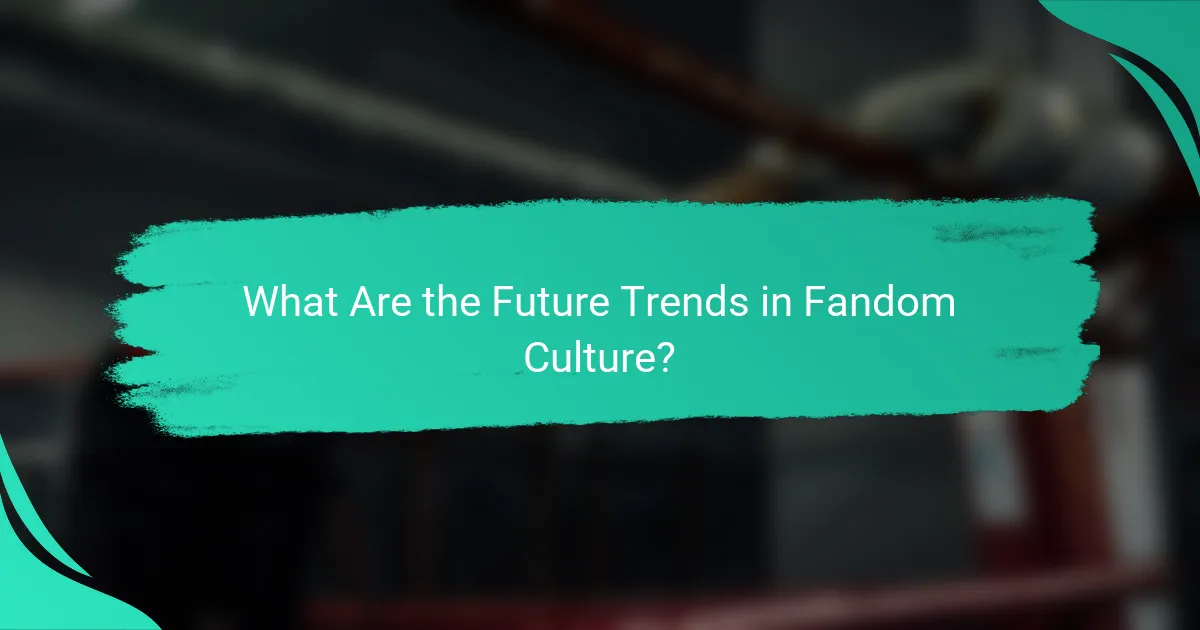
What Are the Future Trends in Fandom Culture?
Future trends in fandom culture are shaped by technological advancements and evolving consumer behaviors. As digital platforms continue to grow, fans will increasingly engage through immersive experiences and personalized content.
Emerging technologies in fan engagement
Emerging technologies such as virtual reality (VR), augmented reality (AR), and artificial intelligence (AI) are transforming how fans interact with their favorite franchises. VR and AR create immersive environments, allowing fans to experience stories in new ways, while AI enhances personalization by recommending content based on user preferences.
For example, VR events can simulate live concerts or movie premieres, enabling fans to participate from anywhere. Brands are also using AI-driven chatbots to provide instant support and engagement, making interactions more dynamic and tailored.
Shifts in content consumption patterns
Content consumption patterns are shifting towards on-demand and interactive formats, reflecting changing audience preferences. Streaming services and social media platforms allow fans to access content anytime, leading to binge-watching and community-driven discussions.
Additionally, user-generated content is becoming increasingly popular, with fans creating their own interpretations and sharing them across platforms. This trend encourages collaboration and fosters a sense of community among fans, as they engage with each other’s creations.
